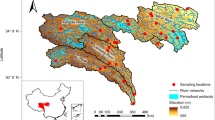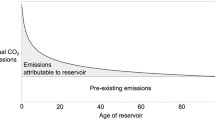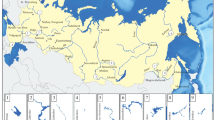Abstract
The United States is home to 2198 dams actively used for hydropower production. With the December 2015 consensus adoption of the United Nations Framework Convention on Climate Change Paris Agreement, it is important to accurately quantify anthropogenic greenhouse gas emissions. Methane ebullition, or methane bubbles originating from river or lake sediments, has been shown to account for nearly all methane emissions from tropical hydropower reservoirs to the atmosphere. However, distinct ebullitive methane fluxes have been studied in comparatively few temperate hydropower reservoirs globally. This study measures ebullitive and diffusive methane fluxes from two eastern Washington reservoirs, and synthesizes existing studies of methane ebullition in temperate, boreal, and tropical hydropower reservoirs. Ebullition comprises nearly all methane emissions (>97%) from this study's two eastern Washington hydropower reservoirs to the atmosphere. Summer methane ebullition from these reservoirs was higher than ebullition in six southeastern U.S. hydropower reservoirs, however it was similar to temperate reservoirs in other parts of the world. Our literature synthesis suggests that methane ebullition from temperate hydropower reservoirs can be seasonally elevated compared to tropical climates, however annual emissions are likely to be higher within tropical climates, emphasizing the possible range of methane ebullition fluxes and the need for the further study of temperate reservoirs. Possible future changes to the Intergovernmental Panel on Climate Change and UNFCCC guidelines for national greenhouse gas inventories highlights the need for accurate assessment of reservoir emissions.




Similar content being viewed by others
References
Aitkenhead JA, McDowell WH (2000) Soil C:N ratio as a predictor of annual riverine DOC flux at local and global scales. Glob Biochem Cycles 14:127–138. doi:10.1029/1999GB900083
Alin SR, de Fátima M, Rasera FL, Salimon CI, Richey JE, Holtgrieve GW, Krusche AV, Snidvongs A (2011) Physical controls on carbon dioxide transfer velocity and flux in low‐gradient river systems and implications for regional carbon budgets. J Geophys Res Biogeosci 116. doi:10.1029/2010JG001398
Aufdenkampe AK, Mayorga E, Raymond PA, Melack JM, Doney SC, Alin SR, Aalto RE, Yoo K (2011) Riverine coupling of biogeochemical cycles between land, oceans, and atmosphere. Front Ecol Environ. doi:10.1890/100014
Barros N, Cole JJ, Tranvik LJ, Prairie YT, Bastviken D, Huszar VL, Del Giorgio P, Roland F (2011) Carbon emission from hydroelectric reservoirs linked to reservoir age and latitude. Nat Geosci 4:593–596. doi:10.1038/ngeo1211
Bartosiewicz M, Laurion I, MacIntyre S (2015) Greenhouse gas emission and storage in a small shallow lake. Hydrobiologia 757:101–115. doi:10.1007/s10750-015-2240-2
Bastviken D, Cole JJ, Pace M, Tranvik L (2004) Methane emissions from lakes: Dependence of lake characteristics, two regional assessments, and a global estimate. Glob Biogeochem Cycles. doi:10.1029/2004GB002238
Bastviken D, Ejlertsson J, Tranvik L (2002) Measurement of methane oxidation in lakes: A comparison of methods. Environ Sci Technol 36:3354–3361. doi:10.1021/es010311p
Bastviken D, Tranvik LJ, Downing JA, Crill PM, Enrich-Prast A (2011) Freshwater methane emissions offset the continental carbon sink. Science 331:50. doi:10.1126/science.1196808
Battin TJ, Luyssaert S, Kaplan LA, Aufdenkampe AK, Richter A, Tranvik LJ (2009) The boundless carbon cycle. Nature 2:598–600. doi:10.1038/ngeo618
Beaulieu JJ, Smolenski RL, Nietch CT, Townsend-Small A, Elovitz MS (2014) High methane emissions from a midlatitude reservoir draining an agricultural watershed. Environ Sci Technol 48:11100–11108. doi:10.1021/es501871g
Bergier I, Novo E, Ramos FM, Mazzi EA, Rasera M (2011) Carbon dioxide and methane fluxes in the littoral zone of a tropical Savanna Reservoir (Corumba, Brazil). Oecologia Australis 15:666–681
Bevelhimer MS, Stewart AJ, Fortner AM, Phillips JR, Mosher JJ (2016) CO2 is the dominant greenhouse gas emitted from six hydropower reservoirs in Southeastern United States during peak summer emissions. Water 8. doi:10.3390/w8010015
Casper P, Maberly SC, Hall GH, Finlay BJ (2000) Fluxes of methane and carbon dioxide from a small productive lake to the atmosphere. Biogeochemistry 49:1–19. doi:10.1023/A:1006269900174
Castillo MM, Allan JD, Sinsabaugh RL, Kling GW (2004) Seasonal and interannual vaiation of bacterial production in lowland rivers of the Orinoco basin. Freshw Biol 49:1400–1414. doi:10.1111/j.1365-2427.2004.01277.x
CBR (Columbia Basin Research) (2013) Columbia River DART (Data Access in Real Time) [online database], Seattle, WA. www.cbr.washington.edu/dart/river.html
Chen H, Wu Y, Yuan X, Gao Y, Wu N, Zhu D (2009) Methane emissions from newly created marshes in the drawdown area of the Three Gorges Reservoir. J Geophys Res Atmos 114:1–7. doi:10.1029/2009JD012410
Chen H, Yuan X, Chen Z, Wu Y, Liu X, Zhu D, Wu N, Zhu Q, Peng C, Li W (2011) Methane emissions from the surface of the Three Gorges reservoir. J Geophys Res Atmos 116. doi:10.1029/2011JD016244
Cole JJ, Caraco NF (1998) Atmospheric exchange of carbon dioxide in a low‐wind oligotrophic lake measured by the addition of SF6. Limnol Oceanogr 43:647–656. doi:10.4319/lo.1998.43.4.0647
Crawford JT, Stanley EH, Spawn SA, Finlay JC, Loken LC, Striegl RG (2014) Ebullitive methane emissions from oxygenated wetland streams. Glob Change Biol 20:3408–3422. doi:10.1111/gcb.12614
Crusius J, Wanninkhof R (2003) Gas transfer velocities measured at low wind speed over a lake. Limnol Oceanogr 48:1010–1017. doi:10.4319/lo.2003.48.3.1010
Deemer BR, Harrison JA, Li S, Beaulieu JJ, DelSontro T, Barros N, Bezerra-Neto JF, Powers SM, dos Santos MA, Vonk JA (2016) Greenhouse gas emissions from reservoir water surfaces: a new global synthesis. BioScience 66:949–964. doi:10.1093/biosci/biw117
Del Sontro T, McGinnis DF, Sobek S, Ostrovsky I, Wehrli B (2010) Extreme methane emissions from a Swiss hydropower reservoir: contribution from bubbling sediments. Environ Sci Technol 44:2419–2425. doi:10.1021/es9031369
Del Sontro T, McGinnis DF, Wehrli B, Ostrovsky I (2015) Size does matter: Importance of large bubbles and small-scale hot spots for methane transport. Environ Sci Technol 49:1268–1276. doi:10.1021/es5054286
Del Sontro T, Kunz MJ, Kempter T, Wüest A, Wehrli B, Senn DB (2011) Spatial heterogeneity of methane ebullition in a large tropical reservoir. Environ Sci Technol 45:9866–9873. doi:10.1021/es2005545
Deshmukh C, Serça D, Delon C, Tardif R, Demarty M, Jarnot C, Meyerfeld Y, Chanudet V, Guédant P, Rode W (2014) Physical controls on CH4 emissions from a newly flooded subtropical freshwater hydroelectric reservoir: Nam Theun 2. Biogeosciences 11:4251–4269. doi:10.5194/bg-11-4251-2014
Diem T, Koch S, Schwarzenbach S, Wehrli B, Schubert C (2012) Greenhouse gas emissions (CO2, CH4, and N2O) from several perialpine and alpine hydropower reservoirs by diffusion and loss in turbines. Aquatic sciences 74:619–635. doi:10.1007/s00027-012-0256-5
Dodds WK, Jones JR, Welch EB (1998) Suggested classification of stream trophic state: distributions of temperate stream types by chlorophyll, total nitrogen, and phosphorus. Water Res 32(5):1455–1462. doi: 10.1016/S0043-1354(97)00370-9
Duchemin E, Lucotte M, Canuel R, Chamberland A (1995) Production of the greenhouse gases CH4 and CO2 by hydroelectric reservoirs of the boreal region. Glob Biogeochem Cycles 9:529–540. doi:10.1029/95GB02202
Duchemin E, Lucotte M, Queiroz A, Canuel R, da Silva H, Almeida D, Dezincourt J, Ribeiro L (2000) Greenhouse gas emissions from an old tropical reservoir in Amazonia: Curuá-Una reservoir. Verh Internat Verein Limnol 27:1391–1395
Duchemin É, Huttunen JT, Tremblay A, Delmas R, Menezes CFS (2006b) Appendix 3 CH4 Emissions from Flooded Land: Basis for Future Methodological Development, 2006 IPCC Guidelines for National Greenhouse Gas Inventories Volume 4 Agriculture, Forestry, and Other Land Use. http://www.ipcc-nggip.iges.or.jp/public/2006gl/pdf/4_Volume4/V4_p_Ap3_WetlandsCH4.pdf
Duchemin É, Lucotte M, Canuel R, Soumis N (2006a) First assessment of methane and carbon dioxide emissions from shallow and deep zones of boreal reservoirs upon ice break‐up. Lakes Reserv Manag 11:9–19. doi:10.1111/j.1440-1770.2006.00285.x
dos Santos MA, Rosa LP, Sikar B, Sikar E, dos Santos EO (2006) Gross greenhouse gas fluxes from hydro-power reservoir compared to thermo-power plants. Energy Policy 34:481–488. doi:10.1016/j.enpol.2004.06.015
Fearnside PM, Pueyo S (2012) Greenhouse-gas emissions from tropical dams. Nat Clim Change 2:382–384. doi:10.1038/nclimate1540
Filstrup CT, Scott JT, Lind O (2009) Allochthonous organic matter supplements and sediment transport in a polymictic reservoir determined using elemental and isotopic ratios. Biogeochemistry 96(1):87–100. doi:10.1007/s10533-009-9346-4
Galy‐Lacaux C, Delmas R, Jambert C, Dumestre JF, Labroue L, Richard S, Gosse P (1997) Gaseous emissions and oxygen consumption in hydroelectric dams: a case study in French Guyana. Glob Biogeochem Cycles 11:471–483. doi:10.1029/97GB01625
Galy‐Lacaux C, Delmas R, Kouadio G, Richard S, Gosse P (1999) Long‐term greenhouse gas emissions from hydroelectric reservoirs in tropical forest regions. Glob Biochem Cycles 13:503–517. doi:10.1029/1998GB900015
Goldenfum JA (2012) Challenges and solutions for assessing the impact of freshwater reservoirs on natural GHG emissions. Ecohydrol Hydrobiol 12:115–122. doi:10.2478/v10104-012-0011-5
Grinham A, Dunbabin M, Gale D, Udy J (2011) Quantification of ebullitive and diffusive methane release to atmosphere from a water storage. Atmos Environ 45:7166–7173. doi:10.1016/j.atmosenv.2011.09.011
Harrison JA, Deemer BR, Birchfield MK, O’Malley MT (2017) Reservoir water-level drawdowns accelerate and amplify methane emission. Environ Sci Technol. doi:10.1021/acs.est.6b03185
Heiri O, Lotter AF, Lemcke G (2001) Loss on ignition as a method for estimating organic and carbonate content in sediments: reproducibility and comparability of results. J Paleolimnol 25:101–110. doi:10.1023/A:1008119611481
Herold A, Monni S, Lin E, Meyer CP (2006) Chapter 4 Methodological Choice and Identification of Key Categories, 2006 IPCC Guidelines for National Greenhouse Gas Inventories Volume 1 General Guidance and Reporting. http://www.ipcc-nggip.iges.or.jp/public/2006gl/pdf/1_Volume1/V1_4_Ch4_MethodChoice.pdf
Huttunen JT, Väisänen TS, Hellsten SK, Heikkinen M, Nykänen H, Jungner H, Niskanen A, Virtanen MO, Lindqvist OV, Nenonen OS (2002) Fluxes of CH4, CO2, and N2O in hydroelectric reservoirs Lokka and Porttipahta in the northern boreal zone in Finland. Glob Biogeochem Cycles 16:3–17. doi:10.1029/2000GB001316
Ibarra G, De la Fuente A, Contreras M (2015) Effects of hydropeaking on the hydrodynamics of a stratified reservoir: the Rapel Reservoir case study. J Hydraul Res 53:760–772. doi:10.1080/00221686.2015.1060271
Jacinthe P, Filippelli G, Tedesco L, Raftis R (2012) Carbon storage and greenhouse gases emission from a fluvial reservoir in an agricultural landscape. Catena 94:53–63. doi:10.1016/j.catena.2011.03.012
Joyce J, Jewell PW (2003) Physical controls on methane ebullition from reservoirs and lakes. Environ Eng Geosci 9(2):167–178. doi:10.2113/9.2.167
Kao SC, McManamay RA, Stewart KM, Samu NM, Hadjerioua B, DeNeale ST, Yeasmin D, Fayzul M, Pasha K, Oubeidillah AA, Smith BT (2014) New stream-reach development: A comprehensive assessment of hydropower energy potential in the United States. Report from Oak Ridge National Laboratory for the US Department of Energy, DOE/EE-1063, Oak Ridge National Laboratory, Oak Ridge, TN
Keller M, Stallard RF (1994) Methane emission by bubbling from Gatun Lake, Panama. J Geophys Res Atmos 99:8307–8319. doi:10.1029/92JD02170
Kelly C, Rudd J, Bodaly R, Roulet N, Louis StV, Heyes A, Moore T, Schiff S, Aravena R, Scott K (1997) Increases in fluxes of greenhouse gases and methyl mercury following flooding of an experimental reservoir. Environ Sci Technol 31:1334–1344. doi:10.1021/es9604931
Kling GW, Kipphut GW, Miller MM, O’Brien WJ (2000) Integration of lakes and streams in a landscape perspective: The importance of material processing on spatial patterns and temporal coherence. Freshw Biol 43:477–497. doi:10.1046/j.1365-2427.2000.00515.x
Louis VLS, Kelly CA, Duchemin E, Rudd JW, Rosenberg DM (2000) Reservoir surfaces as sources of greenhouse gases to the atmosphere: a global estimate reservoirs are sources of greenhouse gases to the atmosphere, and their surface areas have increased to the point where they should be included in global inventories of anthropogenic emissions of greenhouse gases. BioScience 50:766–775. doi: 10.1641/0006-3568(2000)050[0766:RSASOG]2.0.CO;2
Maeck A, Hofmann H, Lorke A (2014) Pumping methane out of aquatic sediments: ebullition forcing mechanisms in an impounded river. Biogeosciences 11:2925–2938. doi:10.5194/bg-11-2925-2014
Maeck A, Del Sontro T, McGinnis DF, Fischer H, Flury S, Schmidt M, Fietzek P, Lorke A (2013) Sediment trapping by dams creates methane emission hot spots. Environ Sci Technol 47:8130–8137. doi:10.1021/es4003907
Martinez D, Anderson MA (2013) Methane production and ebullition in a shallow, artificially aerated, eutrophic temperate lake (Lake Elsinore, CA). Sci Total Environ 454:457–465. doi:10.1016/j.scitotenv.2013.03.040
Matthews CJ, Joyce EM, Louis VLS, Schiff SL, Venkiteswaran JJ, Hall BD, Bodaly RD, Beaty KG (2005) Carbon dioxide and methane production in small reservoirs flooding upland boreal forest. Ecosystems 8:267–285. doi:10.1007/s10021-005-0005-x
Mattson MD, Likens GE (1990) Air pressure and methane fluxes. Nature 347:718–719. doi:10.1038/347718b0
Mendonça R, Kosten S, Sobek S, Barros N, Cole JJ, Tranvik L, Roland F (2012) Hydroelectric carbon sequestration. Nature Geoscience 5:838–840. doi:10.1038/ngeo1653
Mosher JJ, Fortner AM, Phillips JR, Bevelhimer MS, Stewart AJ, Troia MJ (2015) Spatial and temporal correlates of greenhouse gas diffusion from a hydropower reservoir in the Southern United States. Water 7:5910–5927. doi:10.3390/w7115910
Ostrovsky I, McGinnis DF, Lapidus L, Eckert W (2008) Quantifying gas ebullition with echosounder: the role of methane transport by bubbles in a medium-sized lake. Limnol Oceanogr Methods 6:18. doi:10.4319/lom.2008.6.105
Ramos FM, Lima IB, Rosa RR, Mazzi EA, Carvalho JC, Rasera MF, Ometto JP, Assireu AT, Stech JL (2006) Extreme event dynamics in methane ebullition fluxes from tropical reservoirs. Geophys Res Lett 33. doi:10.1029/2006GL027943
Rosa LP, Dos Santos MA, Matvienko B, Sikar E, Lourenço RSM, Menezes CF (2003) Biogenic gas production from major Amazon reservoirs, Brazil. Hydrological Processes 17:1443–1450. doi:10.1002/hyp.1295
Rudd JW, Hecky R, Harris R, Kelly C (1993) Are hydroelectric reservoirs significant sources of greenhouse gases? Ambio 22:246–248
Sobek S, Del Sontro T, Wongfun N, Wehrli B (2012) Extreme organic carbon burial fuels intense methane bubbling in a temperate reservoir. Geophys Res Lett. 39. doi:10.1029/2011GL050144
Soumis N, Duchemin E, Canuel R, Lucotte M (2004) Greenhouse gas emissions from reservoirs of the western United States. Global Biogeochem Cycles. 18. doi:10.1029/2003GB002197
Soumis N, Lucotte M, Canuel R, Weissenberger S, Houel S, Larose C, Duchemin E (2005) Hydroelectric reservoirs as anthropogenic sources of greenhouse gases. Surf Water Hydrol. doi:10.1002/047147844X.sw791
Strayer RF, Tiedje JM (1978) In situ methane production in a small, hypereutrophic, hard-water lake: Loss of methane from sediments by vertical diffusion and ebullition. Limnol Oceanogr 23:1201–1206. doi:10.4319/lo.1978.23.6.1201
Sturm K, Yuan Z, Gibbes B, Werner U, Grinham A (2014) Methane and nitrous oxide sources and emissions in a subtropical freshwater reservoir, South East Queensland, Australia. Biogeosciences 11:5245–5258. doi:10.5194/bg-11-5245-2014
Taylor J (1997) An introduction to error analysis. University Science Books, Sausalito, CA
Teodoru CR, Bastien J, Bonneville MC, Giorgio PA, Demarty M, Garneau M, Hélie JF, Pelletier L, Prairie YT, Roulet NT (2012) The net carbon footprint of a newly created boreal hydroelectric reservoir. Glob Biochem Cycles 26. 10.1029/2011GB004187
Thornton KW, Kimmel BL, Payne FE (1990) Reservoir limnology: Ecological perspectives. Wiley, New York, NY
Tremblay A (2005) Greenhouse gas Emissions-Fluxes and Processes: Hydroelectric reservoirs and natural environments. Springer, New York, NY
Trojanowska A, Kurasiewicz M, Plesniak L, Jedrysek M (2009) Emission of methane from sediments of selected Polish dam reservoirs. Teka Komisji Ochrony i Kształtowania Środowiska Przyrodniczego 6:368–373
UNFCCC (2014) Reporting requirements. http://unfccc.int/national_reports/annex_i_ghg_inventories/reporting_requirements/items/2759.php. Accessed 26 Dec 2015
UNFCCC (2015) Adoption of the Paris Agreement. Proposal by the President (FCCC/CP/2015/L.9/Rev.1), 12 Dec 2015. http://unfccc.int/resource/docs/2015/cop21/eng/l09r01.pdf
Uría-Martínez R, O’Connor PW, Johnson MM (2015) 2014 Hydropower Market Report. Report from Oak Ridge National Laboratory for the US Department of Energy, DOE/EE-1195, Oak Ridge National Laboratory, Oak Ridge, TN
USACE (2015) National Inventory of Dams US Army Corps of Engineers. http://nid.usace.army.mil/cm_apex/f?p=838:4:0::NO. Accessed 19 Dec 2015
USEPA (2015) About the Emissions Inventory. US Greenhouse Gas Inventory Report: 1990–2013. http://www3.epa.gov/climatechange/ghgemissions/usinventoryreport.html. Accessed 26 Dec 2015
Vachon D, Prairie YT (2013) The ecosystem size and shape dependence of gas transfer velocity versus windspeed relationships in lakes. Can J Fish Aquat Sci 70(2):1757–1764. doi:10.1139/cjfas-2013-0241
Walter KM, Zimov SA, Chanton JP, Verbyla D, Chapin III FS (2006) Methane bubbling from Siberian thaw lakes as a positive feedback to climate warming. Nature 443:71–75. doi:10.1038/nature05040
Wanninkhof R (1992) Relationship between wind speed and gas exchange. J Geophys Res 97:7373–7382. doi:10.1029/92JC00188
Wilcock RJ, Sorrell BK (2008) Emissions of greenhouse gases CH4 and N2O from low-gradient streams in agriculturally developed catchments. Water Air Soil Pollut 188:155–170. doi:10.1007/s11270-007-9532-8
Wilhelm E, Battino R, Wilcock RJ (1977) Low-pressure solubility of gases in liquid water. Chem Rev 77:219–262. doi:10.1021/cr60306a003
Wilkinson J, Maeck A, Alshboul Z, Lorke A (2015) Continuous seasonal river ebullition measurements linked to sediment methane formation. Environ Sci Technol 49:13121–13129. doi:10.1021/acs.est.5b01525
Yvon-Durocher G, Allen AP, Bastviken D, Conrad R, Gudasz C, St-Pierre A, Thanh-Duc N, Del Giorgio PA (2014) Methane fluxes show consistent temperature dependence across microbial to ecosystem scales. Nature 507:488–495. doi:10.1038/nature13164
Yvon-Durocher G, Caffrey JM, Cescatti A, Dossena M, Del Giorgio PA, Gasol JM, Montoya JM, Pumpanen J, Staehr PA, Trimmer M, Woodwated G, Allen AP (2012) Reconciling the temperature dependence of respiration across timescales and ecosystem types. Nature 487:472–476. doi:10.1038/nature11205
Zhao Y, Wu B, Zeng Y (2013) Spatial and temporal patterns of greenhouse gas emissions from Three Gorges reservoir of China. Biogeosciences 10:1219–1230. doi:10.5194/bg-10-1219-2013
Acknowledgements
This work was funded by the US Department of Energy, Office of Energy Efficiency and Renewable Energy Wind and Water Power Program. Support was also provided by the US Department of Energy, Office of Biological and Environmental Research, as part of Subsurface Biogeochemical Research Program’s Scientific Focus Area at the Pacific Northwest National Laboratory (PNNL). PNNL is operated by Battelle for the US Department of Energy under Contract DE-AC06-76RL01830. We thank A. Stewart, M. Bevelhimer, J. Mosher, J. Phillips, and A. Fortner (Oak Ridge National Laboratory) for advice on data acquisition and analysis. We also thank K. Ham, K. Klett, S. Niehus, A. O’Toole, T. Resch, J. Serkowski, and C. Thompson (Pacific Northwest National Laboratory) for assistance with study conception, data acquisition, and analysis.
Author information
Authors and Affiliations
Corresponding author
Ethics declarations
Conflict of interest
The authors declare that they have no competing interests.
Rights and permissions
About this article
Cite this article
Miller, B.L., Arntzen, E.V., Goldman, A.E. et al. Methane Ebullition in Temperate Hydropower Reservoirs and Implications for US Policy on Greenhouse Gas Emissions. Environmental Management 60, 615–629 (2017). https://doi.org/10.1007/s00267-017-0909-1
Received:
Accepted:
Published:
Issue Date:
DOI: https://doi.org/10.1007/s00267-017-0909-1




